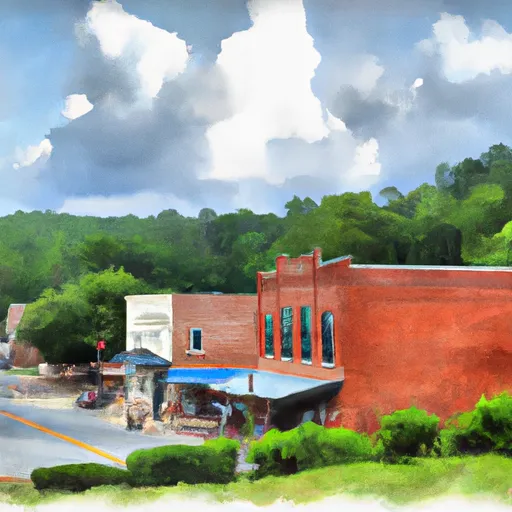-
 Snoflo Premium
Snoflo Premium
Get unlimited access to all our content
With no Ad interruptions! - Start Your Free Trial Login with existing account
Mineral-Bluff
Eden Index
Climate
7.3
•
Recreation
2.6
•
Community
•
Safeguard
3.8/10

Mineral Bluff is a small town located in the northern part of Georgia, United States. It experiences a humid subtropical climate, with mild winters and hot summers. The average annual temperature in Mineral Bluff is around 60°F (15.5°C), with July being the warmest month and January the coldest.
The town is surrounded by picturesque landscapes, including numerous rivers and creeks. The area is known for its hydrology constituents, with the Toccoa River flowing nearby. This river is a popular spot for fishing, kayaking, and canoeing. It is a prime location for anglers, as it is abundant in various fish species, including trout.
In addition to its hydrology, Mineral Bluff offers a range of outdoor recreational activities. The nearby Chattahoochee National Forest provides opportunities for hiking, camping, and wildlife viewing. The Benton MacKaye Trail, a long-distance hiking trail, passes through the area, offering stunning views of the Appalachian Mountains.
Overall, Mineral Bluff, Georgia, offers a pleasant climate, beautiful hydrology features, and abundant outdoor recreation opportunities, making it an ideal destination for nature enthusiasts and adventure seekers.
What is the Eden Index?
The Snoflo Eden Index serves as a comprehensive rating system for regions, evaluating their desirability through a holistic assessment of climate health, outdoor recreation opportunities, and natural disaster risk, acknowledging the profound impact of these factors on livability and well-being.
Climate Health Indicator (CHI): 7.3
Mineral-Bluff receives approximately
1537mm of rain per year,
with humidity levels near 82%
and air temperatures averaging around
14°C.
Mineral-Bluff has a plant hardyness factor of
7, meaning
plants and agriculture in this region tend to thrive during the non-winter months.
By considering the ideal temperature range, reliable water supplies, clean air, and stable seasonal rain or snowpacks, the Climate Health Indicator (CHI) underscores the significance of a healthy climate as the foundation for quality living.
A healthy climate is paramount for ensuring a high quality of life and livability in a region, fostering both physical well-being and environmental harmony. This can be characterized by ideal temperatures, reliable access to water supplies, clean air, and consistent seasonal rain or snowpacks.
Weather Forecast
Streamflow Conditions
Middle Tennessee-Hiwassee
Area Rivers
Middle Tennessee-Hiwassee
Snowpack Depths
Middle Tennessee-Hiwassee
Reservoir Storage Capacity
Middle Tennessee-Hiwassee
Groundwater Levels
Recreational Opportunity Index (ROI): 2.6
The Recreational Opportunity Index (ROI) recognizes the value of outdoor recreational options, such as parks, hiking trails, camping sites, and fishing spots, while acknowledging that climate plays a pivotal role in ensuring the comfort and consistency of these experiences.
Access to outdoor recreational opportunities, encompassing activities such as parks, hiking, camping, and fishing, is crucial for overall well-being, and the climate plays a pivotal role in enabling and enhancing these experiences, ensuring that individuals can engage in nature-based activities comfortably and consistently.
Camping Areas
| Campground | Campsites | Reservations | Toilets | Showers | Elevation |
|---|---|---|---|---|---|
| Bald Ridge Creek | None | 1,097 ft | |||
| Morganton Point | 82 | 1,753 ft | |||
| Frank Gross | 9 | 2,356 ft | |||
| Sawnee | None | 1,070 ft | |||
| Deep Hole | 18 | 1,993 ft | |||
| Poteete Creek | None | 1,832 ft | |||
| Amicalola Falls State Park | None | 1,779 ft | |||
| Mulky | 11 | 2,172 ft | |||
| Stone Mountain Park Campground | 430 | 1,558 ft | |||
| Cooper Creek | 17 | 2,164 ft |
Nearby Ski Areas
Catastrophe Safeguard Index (CSI):
The Catastrophe Safeguard Index (CSI) recognizes that natural disaster risk, encompassing floods, fires, hurricanes, and tornadoes, can drastically affect safety and the overall appeal of an area.
The level of natural disaster risk in a region significantly affects safety and the overall livability, with climate change amplifying these risks by potentially increasing the frequency and intensity of events like floods, fires, hurricanes, and tornadoes, thereby posing substantial challenges to community resilience and well-being.
Community Resilience Indicator (CRI):
The Community Resilience Indicator (CRI) recognizes that education, healthcare, and socioeconomics are crucial to the well-being of a region. The CRI acknowledges the profound impact of these elements on residents' overall quality of life. By evaluating educational resources, healthcare accessibility, and economic inclusivity, the index captures the essential aspects that contribute to a thriving community, fostering resident satisfaction, equity, and social cohesion.

